Nobody in this great edifice of American public health that is the CDC—the gold standard for the whole world, journalists will write and write again—is yet wearing a mask.
The president of the United States of America is the emcee, clad in the casual costume he wears for events slightly more important than golfing but less serious than his official duties—including hustling foreign leaders and rousing the rabble at rallies. He’s zipped his White House bomber jacket (retails for $122 at the White House Gift Shop at the time of this writing, presidential seal above the left breast) over his gut. White dress shirt. Red MAGA hat, brim cocked level just above the raccoon white circles around his eyes.
A man named Dr. Steve Monroe, colorless and quivering, stands by. He is the guy who has drawn the short straw of explaining to the media just what the hell is going on with the strange, slow rollout of the CDC’s Covid tests.
 No one knows yet how bad it’s going to get. But it is impossible to look atfootage of the scenenow without an uncanny shiver. The room behind the men is lab-white, festooned with black wires dangling above desktop computers. Georgia Senator Kelly Loeffler—fresh off allegations that she did some insider trading off the pandemic briefing she received before the market crashed—and Governor Brian Kemp are there too, notching a photo op with the big guy.
No one knows yet how bad it’s going to get. But it is impossible to look atfootage of the scenenow without an uncanny shiver. The room behind the men is lab-white, festooned with black wires dangling above desktop computers. Georgia Senator Kelly Loeffler—fresh off allegations that she did some insider trading off the pandemic briefing she received before the market crashed—and Governor Brian Kemp are there too, notching a photo op with the big guy.
There’s been a bit of a problem with the tests, Dr. Monroe avers, without addressing the elephant in the room, the major discrepancies between Donald Trump saying “anyone that wants a test can get a test” and his Health and Human Services (HHS) secretary, Alex Azar, claiming “four million tests [would be] available by the end of next week,” and what the CDC’s star virus hunter, Anne Schuchat, has just told Congress: that the CDC has conducted only 3,000 tests.
Trump interrupts Monroe right away: “So tell them about how you’ve done with the tests [inaudible] over four million.”
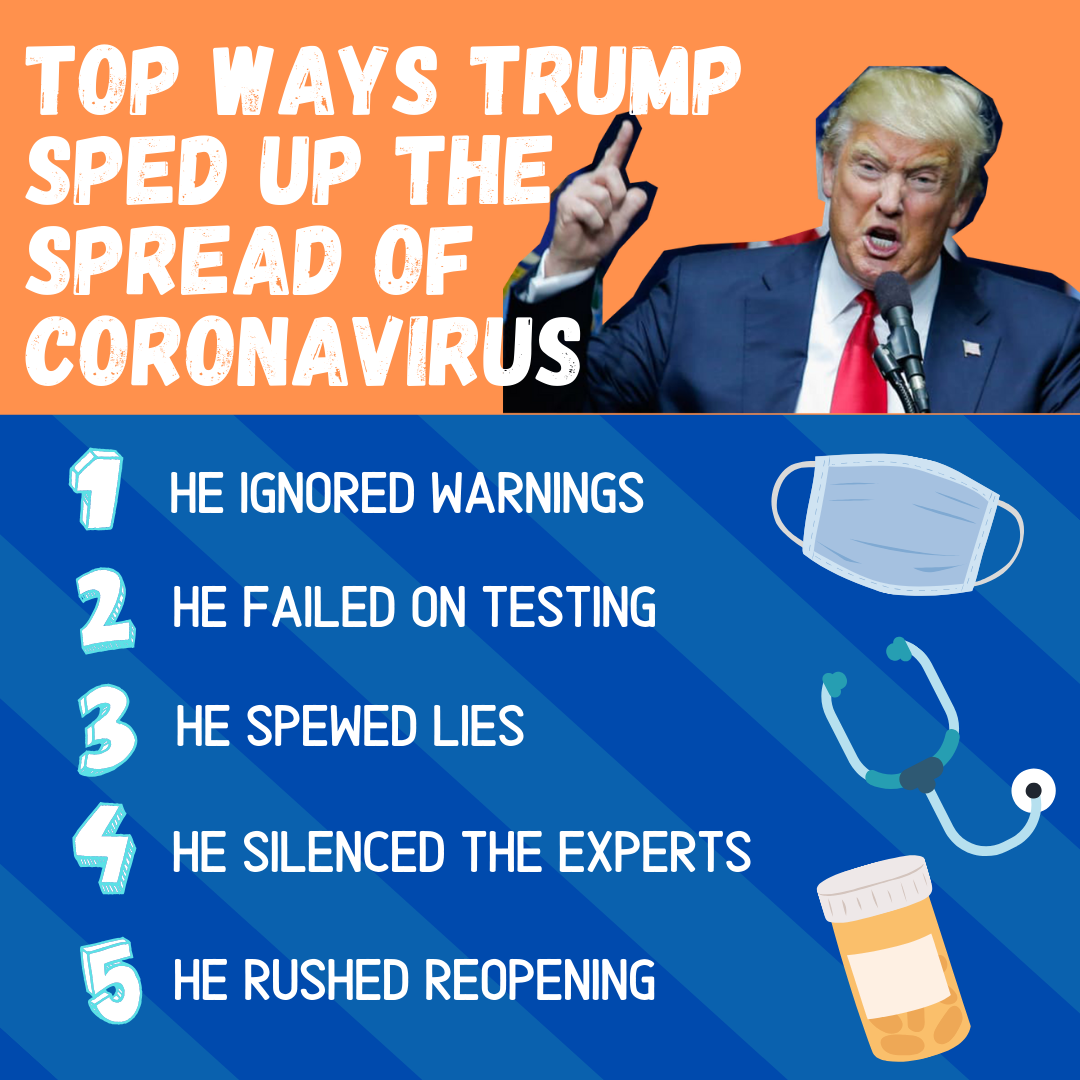 Dr. Monroe, Azar, CDC director Dr. Robert Redfield, and Trump know what no one in the media arrayed before them understands: There will be no mass Covid testing for Americans anytime soon—if ever.
Dr. Monroe, Azar, CDC director Dr. Robert Redfield, and Trump know what no one in the media arrayed before them understands: There will be no mass Covid testing for Americans anytime soon—if ever.
The slow-walked tests were no accident. The Chinese shared a new disease’s genome with the world on January 11, and within days the World Health Organization recommended a rapid test for it and offered it to the world. American infectious disease experts were already alarmed in mid-January, but the Trump regime declined to use it.
He liked the numbers low.
But also, ideology: Trump had already pulled the United States out of UNESCO, the cultural arm of the United Nations, in 2017, followed by the UNHCR, the UN’s refugee agency. So, of course, Trump ignored the recommendations of the WHO.
Screw the WHO and screw your tests. We can do it better.
That decision was, in some ways, the original sin of the pandemic.
It took weeks, until late January, for the CDC to craft and send out its tests. Almost immediately, health labs across the country reported a mistake in the CDC test results. The fix delayed US testing for four more weeks—an eon in virus time. By the time the American government authorized its own test, Covid was rampant, unchecked, spreading human to human in communities, in New York and Seattle and unknown points in between.
It would be impossible to trace or cap.
Trump was OK with that. He liked the numbers low.
 When the National Communicable Disease Center (it would be renamed in 1970) first opened its doors on July 1, 1946, occupying one floor of a small building in Atlanta, the United States was coming out of a world war and the Depression, and there was general agreement that government could be a force for good. The CDC’s primary mission was to prevent the spread of malaria—still a worry in the swamps and electricity-less backwoods of America as far north as New Jersey. Four hundred employees worked with a budget of $10 million to purchase trucks, sprayers, shovels, and labor to eradicate disease-carrying mosquitoes.
When the National Communicable Disease Center (it would be renamed in 1970) first opened its doors on July 1, 1946, occupying one floor of a small building in Atlanta, the United States was coming out of a world war and the Depression, and there was general agreement that government could be a force for good. The CDC’s primary mission was to prevent the spread of malaria—still a worry in the swamps and electricity-less backwoods of America as far north as New Jersey. Four hundred employees worked with a budget of $10 million to purchase trucks, sprayers, shovels, and labor to eradicate disease-carrying mosquitoes.
By the late 1950s, the CDC was becoming the global model of excellence for public health. Its teams were monitoring disease outbreaks and promoting vaccination campaigns around the world. Its elite Epidemic Intelligence Service of globe-trotting disease fighters eventually played a role in eradicating smallpox worldwide, containing Ebola, and performing countless lesser-known missions.
Before the pandemic, America’s CDC was the agency other nations looked to for advice and assistance. The Chinese so revered it that they launched their own CDC intending to meet the standard it set.
At home, though, the CDC was not so popular.
First, for the hard right, what was “public health,” anyway, but socialism?
Second, the CDC was a government agency staffed by elite scientists who infected it with their liberalism and nosed into people’s private decisions. Like how to keep sexually active teen girls from getting pregnant and what to feed kids.
 Third, the agency also collected data that put it at cross- purposes with industry. Some of that data collection provoked outright political battles. Congress had had to step in and stop the CDC’s federal gun-violence studies, for example. Tobacco didn’t cause lung cancer, despite what the scientists at the CDC might think they knew. Since the 1970s, the agency had been a thorn in the side of industry, along with the Occupational Safety and Health Administration, tracking the health effects of environmental degradation from industrial chemicals. The CDC studied cancer clusters in Louisville related to vinyl chloride, and lead poisoning connected to an ore smelter in El Paso.
Third, the agency also collected data that put it at cross- purposes with industry. Some of that data collection provoked outright political battles. Congress had had to step in and stop the CDC’s federal gun-violence studies, for example. Tobacco didn’t cause lung cancer, despite what the scientists at the CDC might think they knew. Since the 1970s, the agency had been a thorn in the side of industry, along with the Occupational Safety and Health Administration, tracking the health effects of environmental degradation from industrial chemicals. The CDC studied cancer clusters in Louisville related to vinyl chloride, and lead poisoning connected to an ore smelter in El Paso.
 The CDC was everything evangelical Christian fanatics wanted to root out. The agency took a common-sense approach to reproductive health and sex education. Its work in the world of sexually transmitted diseases—as well as, eventually, its alliance with Planned Parenthood—sometimes brought it onto the battlefield of the culture wars. The HHS’s policy on the subjects of abortion and contraceptives changed every time the White House changed parties.
The CDC was everything evangelical Christian fanatics wanted to root out. The agency took a common-sense approach to reproductive health and sex education. Its work in the world of sexually transmitted diseases—as well as, eventually, its alliance with Planned Parenthood—sometimes brought it onto the battlefield of the culture wars. The HHS’s policy on the subjects of abortion and contraceptives changed every time the White House changed parties.
Then came AIDS, which initially struck gay men, putting male-to-male anal sex in the scientific and media spotlight. Dr. Redfield and Dr. Deborah Birx are both evangelical Christians whose entries into public health coincided with the AIDS epidemic. Both have been aligned with homophobic organizations. Both were in the Trump administration precisely because those bona fides were more payback to his white evangelical base.
Even before Trump announced he liked the numbers low, members of the pandemic- preparedness community—scientists, medics, policy planners outside the government who studied and made policy recommendations for just such emergencies—were growing more alarmed.
No one could quite believe the federal government of the United States was standing down in the hour of the nation’s greatest need.
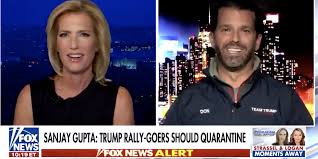 One of those in shock was health-systems expert Dr. Bruce Y. Lee, a CUNY professor and analyst. “In March, people in the community were clamoring, ‘Do something,’” he said. “They were clamoring all over the place, on social media. Public health experts were saying, publicly, ‘Do this. This is what you should do.’ And the response from the White House and from the administration was actually not to do anything.”
One of those in shock was health-systems expert Dr. Bruce Y. Lee, a CUNY professor and analyst. “In March, people in the community were clamoring, ‘Do something,’” he said. “They were clamoring all over the place, on social media. Public health experts were saying, publicly, ‘Do this. This is what you should do.’ And the response from the White House and from the administration was actually not to do anything.”
The pillar of Trump’s political power, contrary to popular belief, was not the “deplorable” rabble that—inexplicably in the eyes of coastal elites and progressives—voted against their own interests on things like national health care and taxing the superrich.
Trump’s true backers were crony capitalists and stone-cold Koch-bro antigovernment ideologues. They were flanked by Rapture-ready religious zealots. Between them, the moneyed and the Godly were behind decades of brainwashing radio and social-media propaganda about brown people getting free stuff and feminists and gay people stealing a generation of children from the Christian patriarchy.
The hard-right long game had always been about preventing poor people, and more precisely poor brown people, from taking free stuff. The philosophy crept close to eugenics: When the poor and frail are aided by government and survive, they weaken the American herd.
The great and strange financier behind Trump during the 2016 election, hedge fund billionaire Robert Mercer, studied for his PhD at the same institution as one of the last American proponents of eugenics in academia, Raymond Cattell. In Mercer’s ideal world, untaxed wealth would be allowed to grow, with corporations and whole industries operating beyond the intrusions of health and safety inspectors, anti-pollution zealots, tree huggers, and lovers of protected snails.
Corporatist libertarians and white evangelical Christians got Trump elected with bold aims: nothing less than the remaking of America into a quantum-age Wild West in which money talks and bullshit walks, women stay home or teeter around on fuck-me shoes, useless animals go extinct, God provides coal and oil for humans to extract, and everyone (supposedly) pulls themselves up by their own bootstraps. In this ideal world, the poor, brown, sick, and weak die off, while the white, wealthy, and healthy survive, ensuring the inherent supremacy of the American gene pool.
The regime would pay back the God squad first by letting them colonize the health and human services agencies, where they could dispense with science and focus on rolling back rights for gay people and women. With the Godly thus occupied, and the agencies’ eyes on controlling sex lives and rolling back the ACA, the regime worked cohesively toward the main goal: demolishing the state.
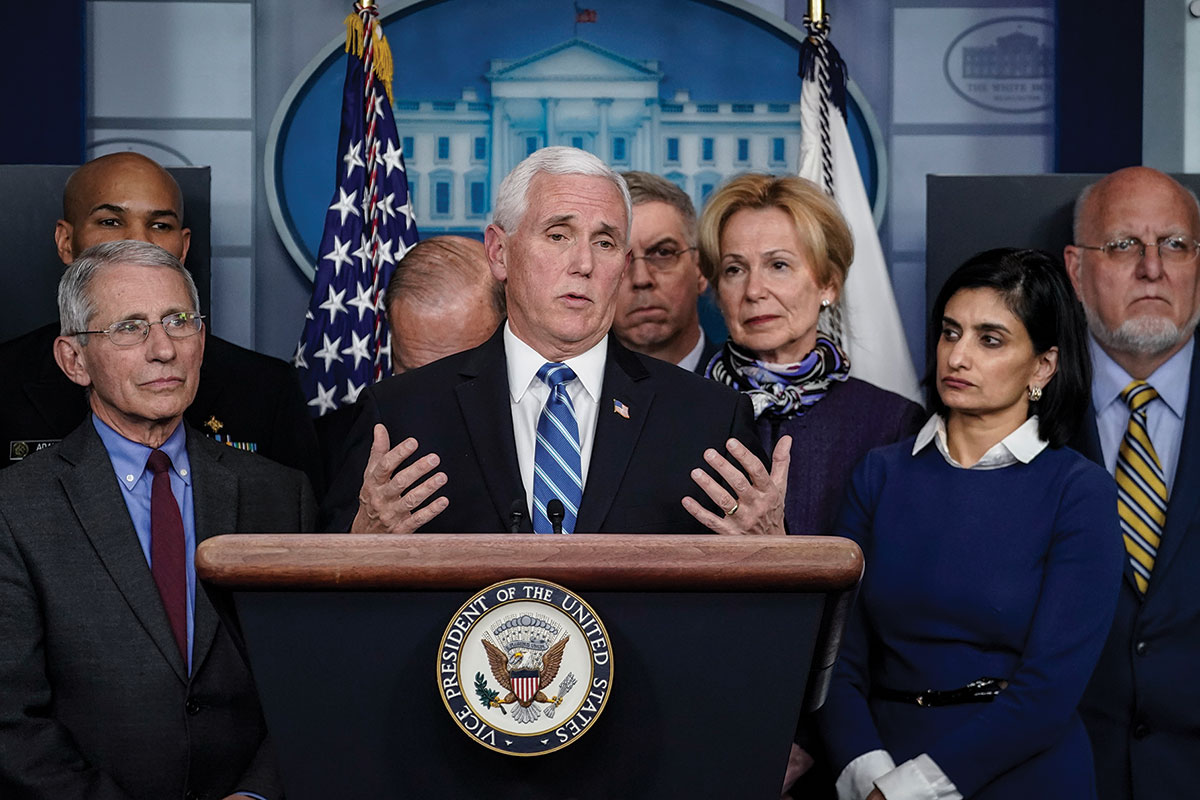 Amateur hour:Anti-science zealot Mike Pence and his dubiously qualified coronavirus task force.(Jim Watson / AFP via Getty Images)
Amateur hour:Anti-science zealot Mike Pence and his dubiously qualified coronavirus task force.(Jim Watson / AFP via Getty Images)
At the White House, there were bigger things to worry about than a virus. It was an election year, and the rampaging bullish stock market was the issue on which Trump was betting his entire reelection. And it was about to go bear. This was the panic he had wanted to avoid when he confessed to Bob Woodward that he didn’t want a panic.
The crash began on Monday, March 9. The Dow fell 2,013.76 points that day to 23,851.02—at the time, its worst single-day point drop in US market history. There would be worse days ahead, as the market continued to plummet. These were bad numbers to the investors, but for millions of working families, it meant job loss, actual hardship.
Within weeks, images of miles-long food lines in California started showing up on TV. Congress scrambled and fought over how much of a safety net the American people might need to get through it, and the president signed the first bailout—the CARES Act. A measly $1,200 stimulus check was mailed. People who qualified for unemployment could go online and try to cover their monthly expenses.
The day after the stock market first rolled off the cliff and started its pandemic downturn, Trump strode into the White House briefing room. This was a true emergency. Not the virus, chumps. The money!
 He had put Vice President Mike Pence—who was standing by in wax figure mode, nodding obsequiously at the man evangelicals had been comparing to Cyrus, the Old Testament Persian king whom God had chosen to save the Jews—in charge of the White House Coronavirus Task Force.
He had put Vice President Mike Pence—who was standing by in wax figure mode, nodding obsequiously at the man evangelicals had been comparing to Cyrus, the Old Testament Persian king whom God had chosen to save the Jews—in charge of the White House Coronavirus Task Force.
It was an interesting choice.
Antipathy to science had been Pence’s political signature throughout his career in Indiana’s congressional delegation and then as governor of the Hoosier State. His career was based on pushing his sect’s moral code on the public through public health agencies and laws.
Before being whisked back to Washington on the Trump magic carpet in 2016, Pence’s parting shot at the reproductive rights of Indiana women was to sign a law requiring funerals for all fetuses, so that a woman who miscarried—even without knowing she was pregnant—might be breaking the law if she didn’t formally cremate or bury the tissue.
Handing off the management of a serious pandemic to a religious zealot instead of a scientist made sense in the Trump administration because his white evangelical supporters were the key to his political survival, and they cared more about controlling people’s sex lives than just about anything else.
Before the pandemic, one plausible reason for why the Trump regime had not kept its eye firmly on disease outbreaks was that it had been focusing its public health efforts on abolishing abortion, restricting access to contraception, and cutting ties with Planned Parenthood. One of the biggest advances Trump touted at the HHS before the pandemic was the launch of a Conscience and Religious Freedom Division for health workers who felt their “religious liberty” was threatened by aspects of their jobs.
 HHS Secretary Azar was a “cabinet sponsor” of evangelical pastor Ralph Drollinger’s Capitol Ministries’ weekly Bible study group, held inside the White House for senior staff. (Drollinger had endeared himself to Trump early by advising him to run America as a “benevolent dictatorship.”) Dr. Redfield—appointed to replace Trump’s first choice for the CDC, a doctor whose investments in tobacco and other sketchy financial deals cost her the job—was a lifelong evangelical Christian who had cut his professional teeth fighting AIDS alongside other evangelicals who were moved as much by homophobic zeal as by Christian mercy. He was famous for having ordered, while in the military, that HIV-positive service members be cordoned off, an arrangement likened to putting the sick in a leper colony.
HHS Secretary Azar was a “cabinet sponsor” of evangelical pastor Ralph Drollinger’s Capitol Ministries’ weekly Bible study group, held inside the White House for senior staff. (Drollinger had endeared himself to Trump early by advising him to run America as a “benevolent dictatorship.”) Dr. Redfield—appointed to replace Trump’s first choice for the CDC, a doctor whose investments in tobacco and other sketchy financial deals cost her the job—was a lifelong evangelical Christian who had cut his professional teeth fighting AIDS alongside other evangelicals who were moved as much by homophobic zeal as by Christian mercy. He was famous for having ordered, while in the military, that HIV-positive service members be cordoned off, an arrangement likened to putting the sick in a leper colony.
Dr. Redfield came across on TV and at congressional hearings as a laconic grandpa, but behind the scenes he accommodated the administration’s need to tamp down the sense of crisis, when good leadership would have demanded that he prepare the public for the severity of what he knew was coming.
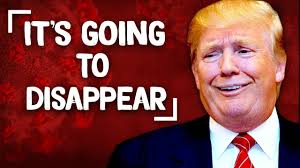 The virus spread invisibly, unchecked by tests. As the world watched in horror the video of corpses being loaded onto refrigerated trucks in New York, a faction of the Trump regime’s inner circle was lifting its head, blinking its yellow eyes, and sniffing the air. The pandemic was actually a fortuitous moment. It was going to make some people very, very rich. They would find opportunity in chaos, fling taxpayer money at private enterprise, enrich already rich friends. Since it was an emergency, and speed was essential, they could dispense with the oversight of government contract officers, federal codes, regulations, procurement databases—all that government muck that hindered the doing of business and the making of money.
The virus spread invisibly, unchecked by tests. As the world watched in horror the video of corpses being loaded onto refrigerated trucks in New York, a faction of the Trump regime’s inner circle was lifting its head, blinking its yellow eyes, and sniffing the air. The pandemic was actually a fortuitous moment. It was going to make some people very, very rich. They would find opportunity in chaos, fling taxpayer money at private enterprise, enrich already rich friends. Since it was an emergency, and speed was essential, they could dispense with the oversight of government contract officers, federal codes, regulations, procurement databases—all that government muck that hindered the doing of business and the making of money.
All they needed was a word from the White House.
InThe Shock Doctrine, Naomi Klein wrote that a strategy of late-stage capitalism is to use—or, if not available, to create and then use—chaos to give the free market a reboot. The chaos playbook is simple, but it requires certain preconditions. Besides a disaster, it needs blind or nonexistent oversight. The Trump regime provided this in the form of no-bid contracts to a small group of large health care suppliers, let them determine distribution, and brought on MBA mini-me “volunteers” to supposedly coordinate this effort.
The federal government had decided that state public officials should compete in the equivalent of a feudal-themed video game, using the tools they had at hand—battle axes, mead, a bag of magic tricks, and a horse—and fighting each other for ventilators, N95 face masks, and other scarce equipment.
That tradition synced up nicely with the goals of the Heritage and Cato foundations, whose minions were quietly leafing through their government-shrinking fantasy-football playbooks. The pandemic offered an unprecedented opportunity to go live after decades of tabletop exercises.
As hospital workers pleaded for help, the White House maintained its focus on its conviction that private enterprise was the way out of this disaster. The administration called for volunteers to staff what would become another public/private bonanza, the White House Covid-19 Supply Chain Task Force, helmed by Trump’s Mr. Fix-It-All, Jared Kushner.
Kushner had an MBA and hung out with Silicon Valley disruptors, and he was credited with the cheap Facebook ad campaign that helped get his father-in-law elected in 2016. A group of dewy-eyed, inexperienced young people answered his call, fresh grads with nothing in their experience that could have prepared them to understand what they were about to be asked to do—much like Kushner himself. Like so much else in the administration’s response, they were off the books—left to use their own laptops and personal e-mail accounts or, better yet, encrypted communication apps like WhatsApp. Eventually, they would be forced to sign the sine qua non of service in Trumpworld, the nondisclosure agreement (NDA).
Twenty-six-year-old Max Kennedy Jr., a grandson of Robert F. Kennedy, was one of the volunteers. He joined the task force when the pandemic put his law school plans on hold, and eventually broke his NDA, writing to Congress and talking to journalists and the filmmaker Alex Gibney. He described a surreal supply acquisition and distribution operation handed off to young people without any logistics experience, operating without direction from or interaction with grown-ups from FEMA or anywhere in the government.
Meanwhile, as summer rolled on, hacks at the HHS were seething with paranoia. They accused CDC scientists of cooking data and science to try to kill Trump’s reelection chances.
----------------------------------------------------
Nina Burleigh is a journalist who has covered stories in most of the contiguous states, Italy, Africa, and the Middle East, as well as the author of seven books, most recently Virus: Vaccinations, the CDC, and the Hijacking of America's Response to the Pandemic.
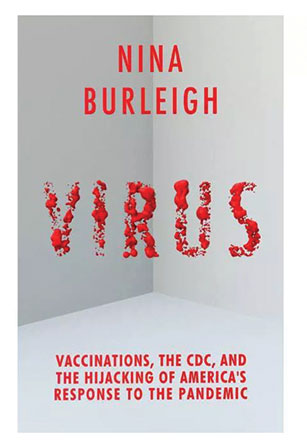 Adapted from Chapter 1 of Nina Burleigh’sVirus, now available from Seven Stories Press.
Adapted from Chapter 1 of Nina Burleigh’sVirus, now available from Seven Stories Press.